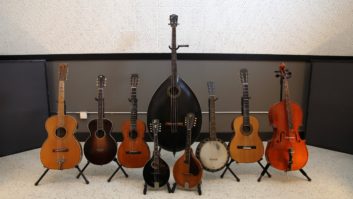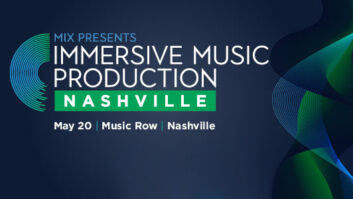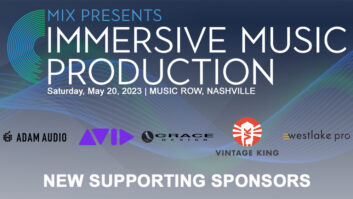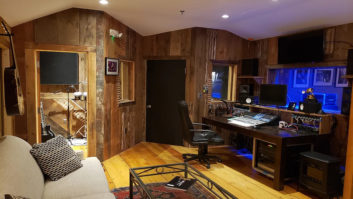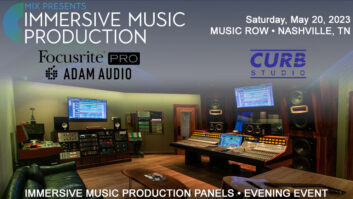Mount Vernon, NY (October 30, 2018)—”For nine years now, we’ve been staying very busy and growing—and almost entirely on art music, and not stuff with any commercial appeal. It’s a little disturbing and perverse, but somehow it has worked out,” laughs Ryan Streber, engineer and co-owner, with studio manager and visual artist Jessica Slaven, of Oktaven Audio.
Indeed, the studio has been successful enough that Streber very recently added to the facility’s pro audio offerings with a newly installed API Legacy AXS console in Oktaven’s 415-square-foot main control room. The 48-channel frame, with on-board patchbay, is fully wired, but fitted with 32 in-line modules with 24 212 mic preamps, 18 550a EQs and four 560 EQs.
“One of the cool things about this new API is that they’ve gone back to the 500 Series EQ slots,” says Streber. “I’m in the process of trying a bunch of 500 Series modules. I may wind up with more API modules, or maybe Rupert Neve Designs 551s. I’m polling visiting engineers to see what they’d prefer.”
The API replaces a venerable Studer 903 broadcast desk, now relocated to a multi-use B room, purchased on eBay after it was used extensively at New York’s Metropolitan Opera. It served him well, says Streber, but imminent tech work would have cost more than it was worth.

“We’ve also been doing more big-band stuff where we needed a lot of inputs and flexibility for cue mixes and headphone sends. The other problem was that we were getting more freelance engineers coming in being faced with this rare, quirky old Studer,” he says.
“I wanted to get something new, reliable, nicely laid out and intuitive, but with a ton of features, and with a warranty. After looking for a while, it came down to API being the only game in town that fit the bill for a large-format analog console that could do everything. No one is really making a traditional, all-discrete analog board that has 12 auxes and can do the things we need to do here comfortably.”
Oktaven—the name is a tribute to Johannes Brahms—primarily records classical, jazz and related music. “We focus on things that involve piano or need some space,” says Streber, a Juilliard-trained composer. The centerpiece of the studio is a 1987 Hamburg Steinway D 9-foot concert grand. A late-fifties New York Steinway D is also available.
Streber, who is also a location sound engineer, and Slaven originally had a smaller space in the adjacent city of Yonkers, just outside New York City. “There’s a perennial problem in New York, which is that—in addition to all of the bigger rooms closing down—there are tons of smaller studios, but a real absence of studios with nice pianos, especially a 9-foot Steinway,” he says.
That space was only temporary, however, and when the expected eviction notice came, they found an industrial space just a quarter-mile north of the Bronx border. “We’re just outside of New York City, but it’s nicely accessible by mass transit and easy to drive to,” says Streber.

“Westchester County has so much crazy wealth, but it’s one of the areas where, if you look hard enough, you can find decently priced, affordable spaces where you can live and work. For us, it’s the only way we could make it work.”
They called in Francis Manzella to design the facility. “He was great. We’ve had unanimously positive feedback from musicians and engineers about the sound of the room. It’s a simple room, a big rectangle, but the proportions are good and it’s lively without being too much so,” he says of the 42-by-30-foot live room, which has a 13-foot ceiling.
The API is paired with Burl converters and a Pro Tools HDX system. There are two Studer A800 MKIII 24-track machines available, but the cost of tape puts them beyond most of his clients’ budgets, Streber reports.
“A really wonderful jazz engineer who works here regularly said, ‘You’ve got an API console, Burl converters and Barefoot monitors. You’re the most rock ‘n’ roll classical studio I’ve ever come across.’ But all these things are designed to sound good, and have high headroom and low noise. It’s big and open-sounding.”
Streber has accumulated an enviable collection of outboard gear over the years, but the preamps have seen little use since he installed the API. “I was so used to outboard preamps going straight into Pro Tools with the console on the back end; that’s how I had worked for the longest time,” he says, “but for the sessions over the last month, I’ve heavily relied on the API for everything. It’s nice to have that workflow; it’s so much faster and more comfortable.”
Oktaven has built an impressive equipment collection on a budget. “We are a studio that has to pay the bills by primarily doing music that basically has no market value. All the stuff we work on is paid for either directly by the artist or crowdfunding or grants. The average album we work on has a pretty small budget, so we’re walking a fine line between trying to be realistic and friendly to the artists, but keeping the quality as high as we can and also somehow keeping the lights on,” he says.
Many of Streber’s tube mics are modern clones, some by the likes of Wunder and Flea. “My most used mics here are M49 clones that I built from kits and mods and parts. All have the same ingredients, based around Thiersch capsules and AMI transformers and power supplies. They look a little different but sound consistent. They sound good on everything and get used all the time—but we also have old RCAs, which are built like tanks.”
For big band work and soloists, a variety of iso rooms—including the B mix/edit room—and soundlocks are available, complete with video tielines. “I use really simple HD-SDI cameras and monitors with direct connections, so there’s almost no latency, and the quality is great. So many of the folks that we work with play in Broadway pit bands where so much now is over video, with click, so it’s a common thing.”
Streber has no complaints about working in such a niche market. “There’s such an abundance of integrity and interesting music, and people doing great stuff that they really believe in. We work on so much different but terrific music. That’s why we do it, at the end of the day.”
Oktaven Audio • www.oktavenaudio.com
API Audio • www.apiaudio.com
